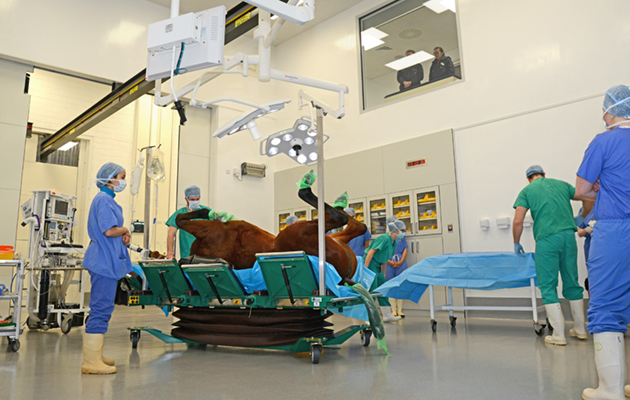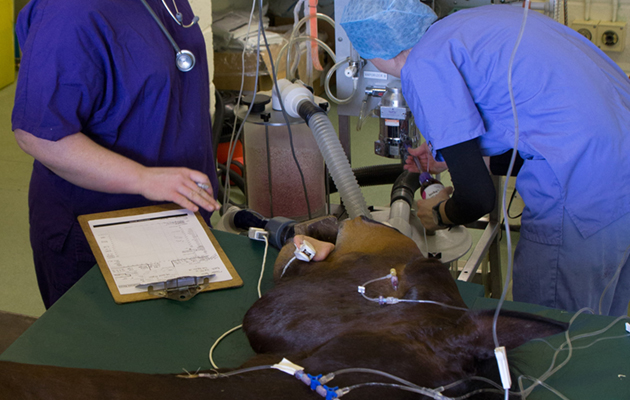Anaesthesia and analgesia (pain control) in horses have advanced considerably over the decades. Undeniably, our ability to provide more effective equine anaesthesia and pain relief has made a big difference to equine health and welfare. It has also allowed increasingly complex and challenging operations to be performed. Colic surgery, for instance, has become almost routine in many major UK equine hospitals, while more intricate orthopaedic operations as well as ear, nose and throat surgeries are now possible.
New developments in medications and techniques have also allowed procedures previously thought possible only under general anaesthesia to be carried out on the standing animal. This is considerably safer for the horse. Dental extractions, sinus drainage, kissing spine correction and even some fracture repairs can now be performed on the standing animal using a combination of sedatives, painkillers and local anaesthetics.
The horse remains awake, however, so must be handled carefully throughout. While he should be pain-free, he may be sufficiently aware to object to an unpleasant procedure — as those who have been kicked by an apparently sedated horse will confirm.
Despite these advances, there remains room for improvement. Many surgical procedures, such as colic surgery, are really only possible under general anaesthesia. It is important for owners to be aware that this is associated with much greater risk for horses compared with other domestic species. When told your horse requires surgery, there may be a tendency to focus on the operation alone and overlook the challenges of anaesthesia.
Two decades ago, a survey involving more than 40,000 equine anaesthetics found an overall death rate of 1.6%. When horses sick with colic and caesarean operations were excluded, the death rate was still about 1%.
The fact that one in 100 seemingly healthy horses undergoing general anaesthesia will be dead within a week of their operation contrasts alarmingly with the figure in humans, which is about one in 10,000, and one in 700 in dogs and cats. The risk is inevitably greater in emergency cases involving sick horses.
Surprisingly, this unsatisfactory figure has not changed appreciably over the past 20 years. It is important, therefore, that anaesthesia and surgery are only ever performed when genuinely justifiable.

Risk factors
The risks of anaesthesia-related tragedies can be reduced with proper training and planning, and by paying meticulous attention to detail. Most anaesthetics are uncomplicated and uneventful, but critical events can occasionally occur for no obvious reason and demand prompt action.
Regrettably, not all cases result in a successful outcome.
The equipment, operators and anaesthetics used are among the factors increasing anaesthetic risk — yet the horse himself is the most significant because of his size and temperament. Unlike people, horses do not lie down quietly and count to 10 as the anaesthetic is injected. Measures are required to ensure that they do not harm themselves or those around them as they collapse at induction (the start of anaesthesia) or when they struggle to stand during recovery.
Cardiac arrest was once thought to be the most common cause of anaesthetic death in horses. Progressive improvement in monitoring and medicines to support the cardiovascular system means that anaesthesia alone is less likely to be fatal.
Unfortunately, and to some extent unavoidably, horses still succumb from anaesthesia during recovery to catastrophes that would not have occurred without anaesthesia — hence the safety of standing surgery. Unexpected fractures can occur during recovery when horses stand clumsily, especially where bone is weakened by surgery, undetected injury or disease. While modern anaesthetic techniques help, recovery from anaesthesia is frequently unpredictable and it is not until the horse is safely back on his feet that an operation can be considered successfully completed.
Different techniques have been used to return a horse safely to a standing position, from leaving him to recover quietly to intervening with ropes or slings. Padded induction and recovery boxes fitted with various means to support the horse are becoming increasingly popular. In some American and Swiss centres, horses are recovered on modified rafts in purpose-designed swimming pools.
Understandably, not all horses are temperamentally suited to this intervention and there is no one fail-safe technique —which is why so many options are being used. A recent survey showed that 40% of equine anaesthetists provide some form of assistance during recovery, although techniques that suit one horse may not be tolerated by others. The reality is that just one unsteady step during the attempt to stand can cause limb dislocation or fracture.

Taking pains
Pain has a major effect on the quality of a horse’s recovery from anaesthesia.
A considerable amount can now be done to make horses more comfortable at this time. Options range from giving phenylbutazone (bute) in minor cases to potent analgesics, such as morphine or newer morphine-like drugs, where required.
Different painkillers can be given in several ways, from sophisticated mixtures administered by intravenous drip to epidural catheters — thin tubes passed into the spine via the head of the tail. The latter are particularly good for controlling chronic, debilitating hindlimb lameness.
Concerns over drug side-effects or fears that painkillers would mask clinical signs have often been used as reasons for not controlling pain, a belief now largely considered groundless. It is now understood that pain itself can produce major problems, often delaying the healing process.
Consequently, analgesics are being used more aggressively and in different ways.
In one such method, now becoming standard practice, analgesics are given prior to surgery and before pain begins, to improve the quality of pain relief — an approach known as pre-emptive analgesia. The potential side-effects of potent drugs are also being minimised by multi-modal treatment, which involves giving a combination of different painkillers at reduced doses. This results in a more comfortable animal and lowers the risk of adverse drug side-effects.
More challenging surgical procedures demand lengthier anaesthetics, which are associated with increased risk for several reasons — not least because a horse is not physically designed to lie on his back for a prolonged period. Remaining in one position under general anaesthesia compresses the muscles upon which he is lying, causing muscle pain, damage and a loss of function when consciousness returns. Similarly, when he is positioned on his back for surgery, the horse’s bulky guts tend to squash his lungs and reduce their ability to inflate and oxygenate blood.
Such changes also occur in humans and smaller animals, but the considerable equine size, along with anatomic adaptations for athletic performance, make the problem considerably worse. Mechanical lung ventilators can help, but do not fully resolve problems with breathing and blood oxygenation.
While minor, brief and simple procedures can be carried out safely in the field, challenging operations must be conducted in an appropriate setting.
An example of a modern centre with cutting-edge facilities is the new equine hospital at the Royal (Dick) School of Veterinary Studies, University of Edinburgh, (pictured, above).
New drugs, equipment and knowledge have improved the outcome, but it is still the skill and dedication of the anaesthetist — together with the whole vet hospital team of surgeons, nurses and grooms — that are key.
The words of the anaesthesia pioneer Dr Robert Smith: “There are no safe anaesthetic drugs, there are no safe anaesthetic techniques; there are only safe anaesthetists”, remain as true as ever when applied to horses.
Ref Horse & Hound; 10 May 2018
